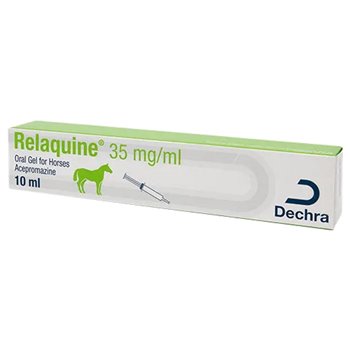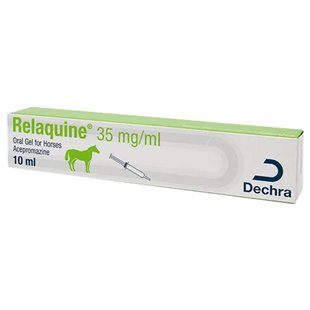Relaquine for Horses is an oral sedative gel used to produce a calming effect in horses that require restraint for handling, transport, or veterinary treatment. Relaquine contains the active ingredient acepromazine maleate, a commonly used tranquiliser in equine medicine. Relaquine is available as a 25mg/ml oral gel and is administered via a pre-filled oral syringe for accurate and convenient dosing.
When administered, Relaquine for Horses produces a calming effect, making it easier for veterinarians and horse owners to manage potentially stressful or uncomfortable situations for the animal. It's worth noting that while Relaquine provides sedation, it does not offer pain relief.
VETERINARY PRESCRIPTION REQUIRED
How Relaquine Works
Relaquine contains acepromazine, a phenothiazine derivative with sedative and anti-anxiety properties. Acepromazine works by altering the activity of certain neu...
Relaquine for Horses is an oral sedative gel used to produce a calming effect in horses that require restraint for handling, transport, or veterinary treatment. Relaquine contains the active ingredient acepromazine maleate, a commonly used tranquiliser in equine medicine. Relaquine is available as a 25mg/ml oral gel and is administered via a pre-filled oral syringe for accurate and convenient dosing.
When administered, Relaquine for Horses produces a calming effect, making it easier for veterinarians and horse owners to manage potentially stressful or uncomfortable situations for the animal. It's worth noting that while Relaquine provides sedation, it does not offer pain relief.
VETERINARY PRESCRIPTION REQUIRED
How Relaquine Works
Relaquine contains acepromazine, a phenothiazine derivative with sedative and anti-anxiety properties. Acepromazine works by altering the activity of certain neurotransmitters in the brain, especially dopamine, which plays a role in controlling mood, behaviour, and movement.
By reducing dopamine activity, acepromazine produces a tranquillising effect without causing full anaesthesia. It helps reduce anxiety and responsiveness to external stimuli, which makes horses calmer and easier to handle. This effect is useful in situations where a horse may become stressed, fearful, or aggressive, such as during clipping, shoeing, dental procedures, or transportation.
Relaquine does not produce pain relief or muscle relaxation, but it lowers a horse’s alertness and reactivity, which contributes to safer and more manageable handling. It is suitable for short-term use and takes effect within a specified period after administration.
Common Uses of Relaquine
Relaquine is prescribed for a range of situations where sedation is beneficial. These include:
- Veterinary examinations and diagnostic procedures
- Dental work or rasping
- Farriery or hoof trimming
- Clipping and grooming
- Loading and unloading for transport
- Minor medical treatments requiring restraint
It is important to use Relaquine only when sedation is necessary and appropriate. The medication should be part of an overall handling plan developed by a vet, especially when used with nervous or difficult horses.
Relaquine Administration and Dosage
Relaquine is supplied in a pre-filled oral syringe containing 10ml of gel. The gel is flavoured and designed to be administered into the horse’s mouth, ideally in the gap between the front and back teeth (diastema) to avoid accidental chewing or swallowing before full absorption.
The dose is calculated based on the horse’s bodyweight. The general guideline is 0.5–1 ml of gel per 100 kg of bodyweight, though the exact dose should be confirmed by the prescribing vet. After administration, the horse should be kept in a calm and quiet environment while the medication takes effect.
The onset of sedation typically begins 30–45 minutes after administration. The duration of effect varies depending on the individual horse and the dose used, but sedation may last for several hours.
Horses should not be given food or water for a short period before and after dosing to ensure proper absorption of the gel from the oral cavity. Care should be taken to avoid spitting or loss of the gel.








